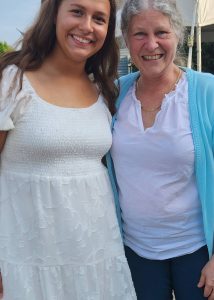
When Cadence Rohrbaugh sent out invitations to her high school graduation party earlier this year, she tucked personal notes into a few special envelopes.
"Dear Dr. Wirrell," Cadence wrote in one. "Thank you so much for helping me and my family through one of the most difficult times ever. Without your care, I would not be alive, healthy and graduating with honors."
Fifteen years earlier, Elaine Wirrell, M.D., had been part of a team that cared for Cadence after she developed epilepsy.
"I wasn't expecting Dr. Wirrell or my other caretakers to come because they are so busy," Cadence says. "But I wanted to let them know about this huge milestone in my life and to thank them for their care."
So even though Cadence had sent the invitation, it still surprised her to see Dr. Wirrell walking up her driveway and back into her life.
"When I saw Dr. Wirrell, it was pure shock," Cadence says. "It was incredible."
A devastating — and familiar — diagnosis
When she first met Dr. Wirrell, director of Pediatric Epilepsy at Mayo Clinic, Cadence was a cheerful, chatty 3-year-old who had begun having seizures. It was a terrifying time for Cadence's parents, especially her mother, Laura Rohrbaugh.
"I have epilepsy," says Laura. "I've been seizure-free since 1990, but I know what a devastating diagnosis it is."
That's why when she and her husband, Richard Rohrbaugh, were completing adoption paperwork, they indicated that they were open to adopting a child with any medical condition, except one.
"I know how terrible epilepsy is, how isolating," Laura says. "I didn't think I could watch a child go through that. But we're believers, and we have faith things happen for a reason."
After Cadence's first seizure, Dr. Wirrell recommended taking a wait-and-see approach before beginning treatment.
"We were told there was a 50-50 chance she'd have another seizure," Laura says. "And at first, nothing happened. It seemed like she'd be fine."
But two months later, Cadence had another seizure. And another. Soon, up to 12 a day.

Cadence was admitted to Mayo Clinic Children's Center and began electroencephalography, or EEG, testing. She also had numerous lab tests, an MRI and a spinal tap before doctors arrived at a diagnosis of myoclonic-atonic epilepsy, also known as Doose syndrome. The rare condition accounts for just 1–2% of childhood epilepsy diagnoses.
"It was evident early on that her seizures were bad," Laura says. "It took only 10 days for her to stop walking, talking or feeding herself. She'd always sucked her fingers for comfort, and she wasn't even able to lift her fingers to her mouth."
Dr. Wirrell prescribed various medications to try to control the seizures. Cadence also had intravenous immunoglobulin treatment that is aimed at normalizing the immune system. Still, the seizures kept coming. That's when Laura asked Dr. Wirrell a question.
"I said, 'Mom to mom, what would you do if this was your child?'" Laura says.
Dr. Wirrell's answer was life-changing for the Rohrbaugh family: "I'd put her on the ketogenic diet."
Life-changing, lifesaving diet
The ketogenic diet, first described at Mayo Clinic in the 1920s, is an extremely high-fat, low-carb diet that causes the body to burn fat instead of carbohydrates. This causes the body to produce chemicals called ketones and go into a state called ketosis. In some people with epilepsy, this state can reduce or eliminate seizures.
"A lot of people hear ketogenic diet and think Atkins diet," Laura says. "But this is totally different."
The diet requires eating precise amounts of food in specific ratios. Everything Cadence ate needed to be weighed or measured, and she needed to clean her plate at every meal. Even her shampoo, sunscreen and soaps — anything that could be absorbed through her skin — had to be keto-compliant.
"The ketogenic diet can be quite time-consuming for families to prepare and follow," Dr. Wirrell says. "When I mentioned this to Cadence's family, their only question was, 'How soon can we start?'"
Laura admits the diet was difficult at first. But the challenge was more than worth it. Within a month of beginning the diet, Cadence was seizure-free.
"We got our girl back," Laura says.
After four years on the ketogenic diet and various medications, Cadence was slowly weaned from both.
"By the time she was 7, Cadence was completely off all medications and the ketogenic diet. And she still remained seizure-free," Laura says. "When she was 8, she was pronounced cured of epilepsy."
Happy tears
Now 18, Cadence remembers very little about her time in the hospital or on the ketogenic diet. But childhood photos and conversations with her parents have helped her understand the important role people like Dr. Wirrell played in her life.

"I was so happy to reconnect with her at my graduation party and tell her all the amazing things I've been able to do because of her," Cadence says.
Things like graduating with honors from John Marshall High School. Serving as drumline captain her senior year. Heading off to South Dakota State University to start the next chapter in her life story.
"It was incredible to look at the photo gallery Cadence's mom and dad had put together and see all that she had done," Dr. Wirrell says. "It was pretty special to connect with the family and nice to share happy tears this time. We are often with families at difficult times, and it is heartwarming to also be included in the celebrations."
It was heartwarming for Laura, too.
"It was incredibly emotional to see Dr. Wirrell again," Laura says. "We were crying, laughing, hugging. What a blessing it was to thank her in person for the gift she gave our family."







